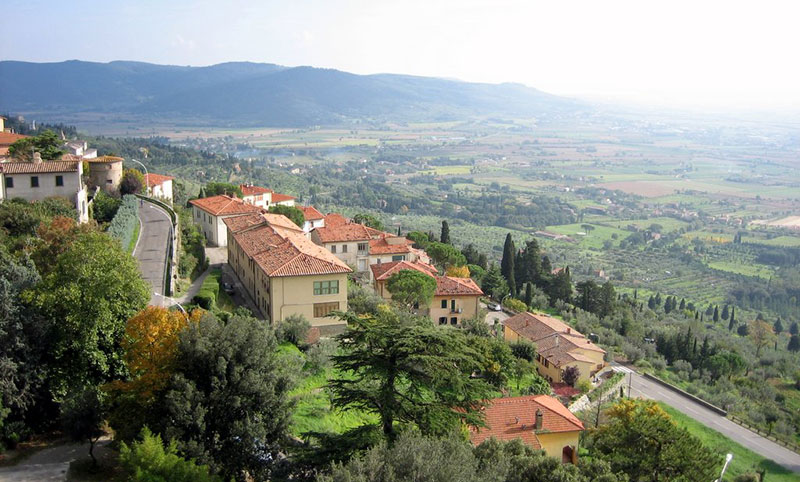
Cortona is a small, welcoming town in the mountains between the Valdichiana and the Tiber valley. It was such an important Etruscan centre that the existence of ancient settlements is still visible today, with its two kilometres of walls dating back to the fifth century BC.
The village is particularly picturesque due to its typically medieval architecture, consisting of ancient palazzos, narrow cobbled streets, small artisan shops and classic Tuscan trattorias. Cortona’s name derives from the Etruscan word Curtun, written in a bronze votive inscription from the third century BC, and is found right in the middle of the town.
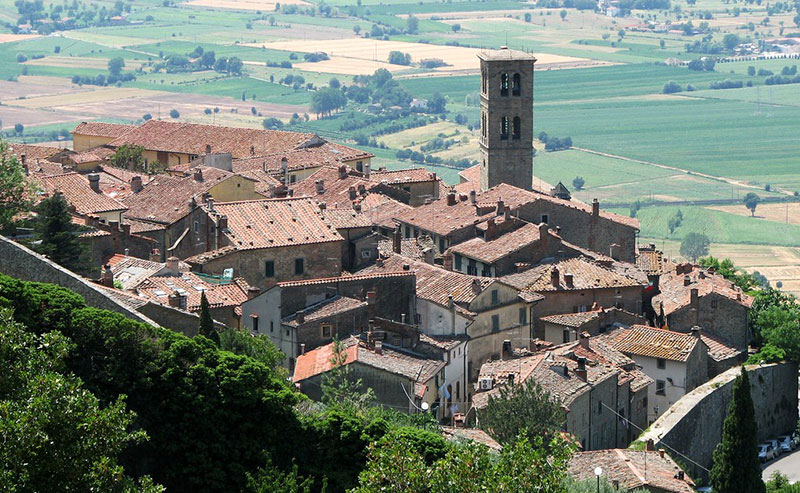
What to see in Cortona
If you are in the historical centre, the beautiful Cathedral of Santa Maria Assunta, built in 1456, is must-see. In 1480, the architect Francesco di Giorgio Martini began constructing the sanctuary of the Madonna delle Grazie in Calcinaio, just outside the city.

Cortona is full of museums and artworks; it is well worth a visit to the Museum of the Etruscan Academy, in which unique historical artifacts are kept. The Diocesan Museum is equally remarkable and collects treasures such as The Annunciation by Beato Angelico and The Deposition by Luca Signorelli. Cortona’s archaeological area, the Fortress of Girifalco and the Abbey of Farneta are also unmissable landmarks.
Nearby
The famous Franciscan convent Le Celle is only a short walk starting from Cortona's centre. You can also explore villas and gardens along the flower trails that lead to Arezzo. The Via Romea also crosses through the city, a 24km road that starts in Castiglion Fiorentino, passes through the Sodo Archaeological Park and ends in Cortona.
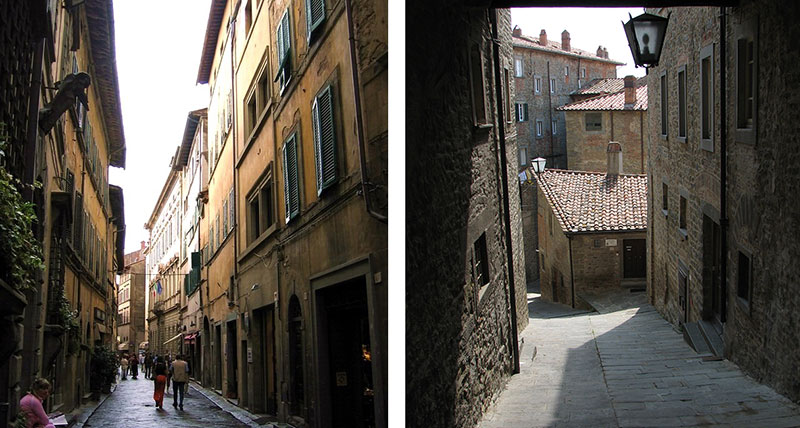
Cortona’s archaeological park includes significant Etruscan and Roman monuments within the historical centre as well as the general area: the system of powerful Etruscan walls that surround the whole of Cortona and the numerous cisterns dating back to Roman times are found within the city. Impressive funerary buildings from the Etruscan period, known as Meloni and Tanelle, are in the wider area. The tumulus (burial mound) II of Sodo is particularly mind-blowing, with its spectacular terraced stairs decorated with sculptures and architectural elements that recall the East.
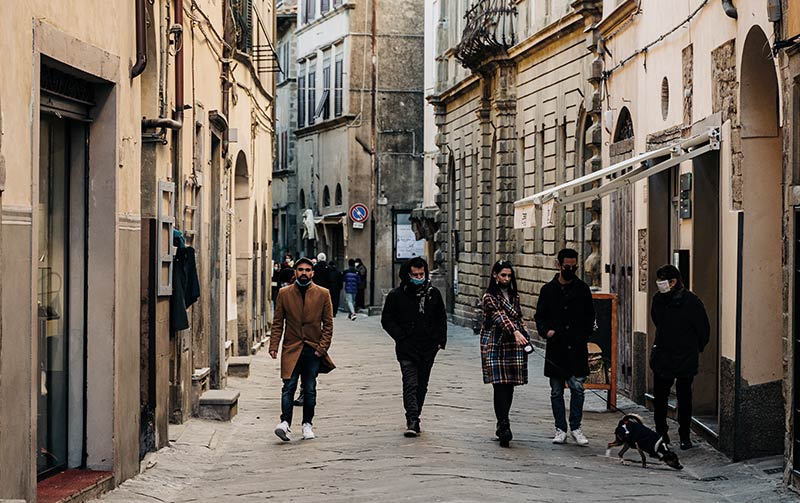
Summer is the perfect time to visit Cortona, with events such as Cortona On The Move, a contemporary photography festival that puts on its exhibition from mid-July to the beginning of October. Every August and September sees the return of Cortonantiquaria, one of the longest-running antique exhibitions in the whole of Italy.
Typical Dishes
Cortona’s gastronomy dates back to rural traditions and many local restaurants still offer historical dishes.
Some of the must-try specialties include: black crostini with Tuscan liver, pici pasta in a meat ragù, pappardelle alla lepre (pappardelle with hare ragù), minestra di pane (bread soup) and the classic fagioli all’uccelletto (a soup-style dish composed of beans, tomatos and sage). We recommend you also try the castagnaccio (chestnut flour cake) and le fritelle di riso (rice fritters), both of which are typical local desserts.
share
ATTRACTIONS IN Cortona
Etruscan Academy Museum
Museum of Rural Culture in Fratticciola
Archeological area in Cortona
Sanctuary of Santa Maria delle Grazie in Calcinaio
Girifalco Castle
Diocesan Museum in Cortona
Cortona city centre
The preceding information is from the Cortona Tourist Information website
https://www.visittuscany.com/en/destinations/cortona/
The following is from Wikipedia on Cortona
https://en.wikipedia.org/wiki/Cortona
Population 22,104
Originally an Umbrian city, it was conquered and enlarged by the Etruscans, who called it Curtun. During the 7th century BC, it joined the Etruscan League.
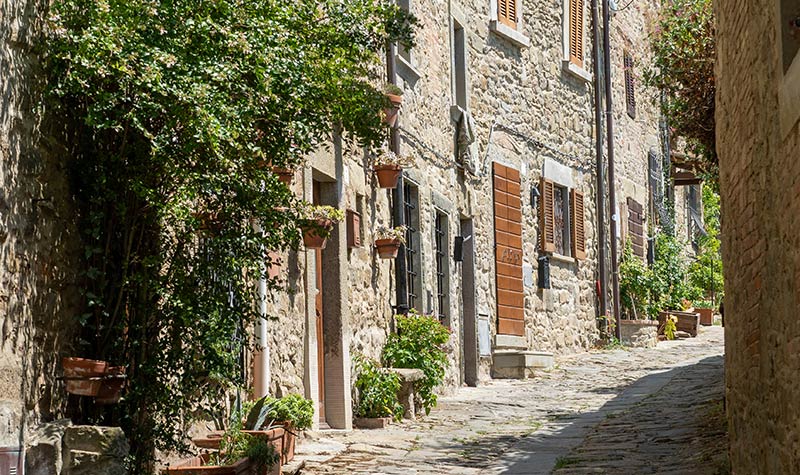
Cortona eventually became a Roman colony under the name Corito. The origin-legends and ancient names of Cortona are described by George Dennis. In the final stages of the Gothic War (535–554), Cortona was sacked and destroyed.
Cortona became a Ghibellinian city state in the 13th century, with its own currency. From 1325 to 1409, the Ranieri-Casali family successfully ruled the town. After being conquered by Ladislaus of Naples in 1409, Cortona was sold to the Medici in 1411. In 1737, the senior branch of the Medici line became extinct and Cortona came under the authority of the House of Lorraine. Following the Italian Wars of Independence, Tuscany—Cortona included—became part of the Kingdom of Italy.
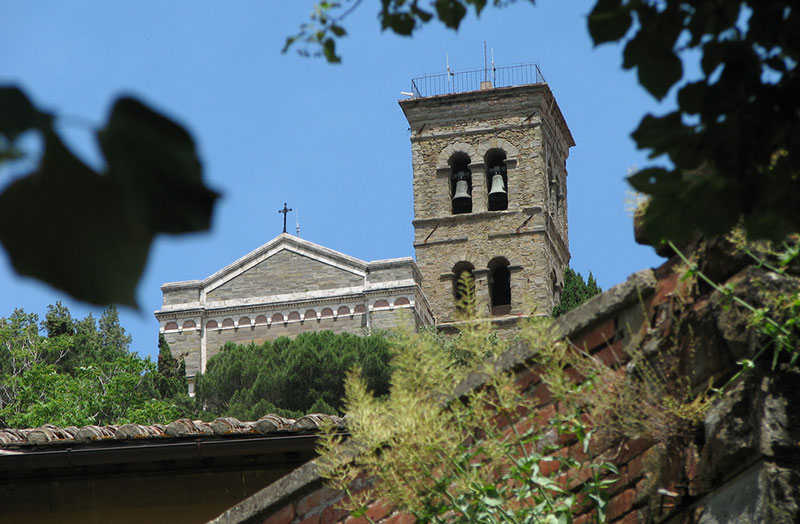
Cortona foundation legend
The foundation of Cortona remains mixed in legends dating to classic times. These were later reworked especially in the late Renaissance period under Cosimo I de' Medici. The 17th-century Guide of Giacomo Lauro, reworked from writings of Annio da Viterbo, states that 108 years after the Great Flood, Noah entered the Valdichiana via the Tiber and Paglia rivers. He preferred this place to anywhere else in Italy, because it was so fertile, and dwelt there for thirty years. One of Noah's descendants was Crano, his son who came to the hilltop and, liking the high position, the fine countryside and the calm air, built the city of Cortona on it in 273 years after the Great Flood.
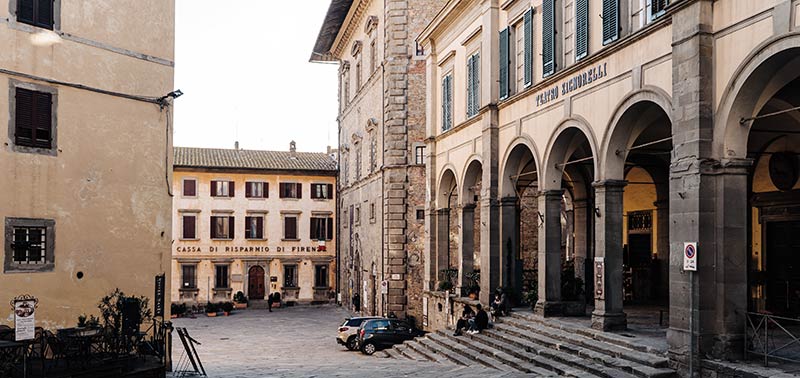
Name of Cortona is derived from Latin Cortōna, and from Etruscan 𐌂𐌖𐌓𐌕𐌖𐌍 (curtun). This may be related to Indo-European *ghortos meaning "enclosed place" and consequently walled city like Latin hortus, German Garten, Italian orto, English yard, and Slavic grad. The name may also be linked to the Phrygian town of Gordium in Anatolia, although the founding myth for the latter is that it was named after founder, King Gordias. However, the Etruscan language is probably a pre-Indo-European language, and therefore if it was named by the Etruscans, an Indo-European etymology is uncertain. The Umbrian language, by contrast, is an Italic language, so if it was named by them, a link to Indo-European roots would be more likely.
It was known by many names "Corytus, Croton, Crotona, Cyrtonion, Creston, Gotynaea, Cothernia, or Cortona. The latter name, if we may believe Dionysius (Dionysius Periegetes) (I. p21) was only given when the city was made a Roman colony, not long before his day, taking the place of the old appellation, Croton. Of Corythus, we have already spoken. Cyrtonios or Cyrtonion is the name used by Polybius (III.82) and Stephanus of Byzantium. Creston is found only in Herodotus, and will be further mentioned presently. Cortynaea is used by Lycophron (Cass. 806), and by Theopompus (ap. Tzetz. ad Lycoph. loc. cit.), who records a tradition that Ulysses, called by the Etruscans, Nanos (cf. Lycoph. 1244; Tzetzes in loc.), sailed to Etruria, took up his abode at Gortynaea, and there died. This says Müller is the Hellenised form of Cortona, for no other Etruscan city can be here intended.
Cortona DOC
In 2000, Cortona established Cortona DOC (Denominazione di Origine Controllata), which has 29 members that produce and control 14 different types of wines.
Main sights
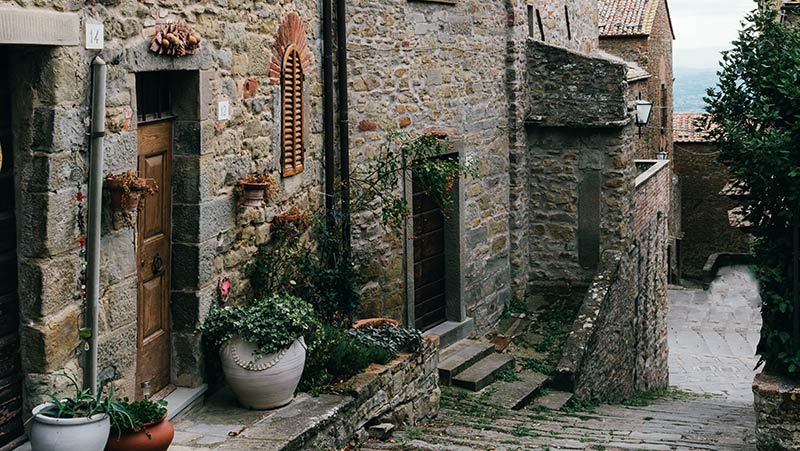
The prevailing character of Cortona's architecture is medieval with steep narrow streets situated on a hillside at an elevation of 600 metres (2,000 ft) that embraces a view of the whole of the Valdichiana. From the Piazza Garibaldi (still referred to by the local population by its older name, Piazza Carbonaia) is a fine prospect of Lake Trasimeno, scene of Hannibal's ambush of the Roman army in 217 BC (Battle of Lake Trasimene). Parts of the Etruscan city wall can still be seen today as the basis of the present wall. The main street, via Nazionale, is the only street in the town with no gradient, and is still usually referred to by locals by its older name of Ruga Piana.
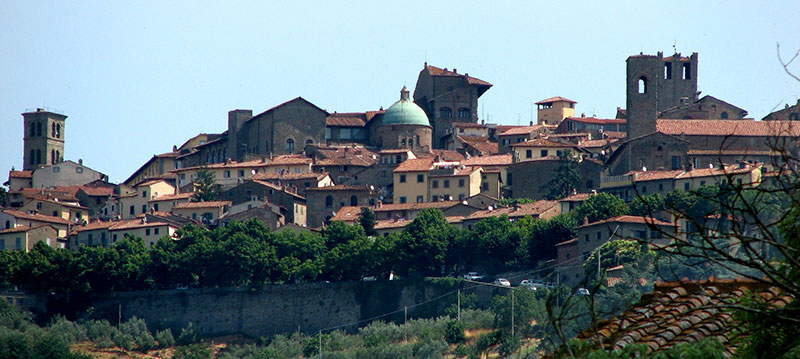
Inside the Palazzo Casali is the Museo dell'Accademia Etrusca, displaying items from Etruscan, Roman, and Egyptian civilizations, as well as art and artefacts from the Medieval and Renaissance eras. The distinguished Etruscan Academy Museum had its foundation in 1727 with the collections and library of Onofrio Baldelli. Among its most famous ancient artefacts is the bronze lampadario or Etruscan hanging lamp, found at Fratta near Cortona in 1840 and then acquired by the Academy for the large sum of 1600 Florentine scudi. Its iconography includes (under the 16 burners) alternating figures of Silenus playing panpipes or double flutes, and of sirens or harpies. Within zones representing waves, dolphins and fiercer sea-creatures is a gorgon-like face with protruding tongue. Between each burner is a modelled horned head of Achelous. It is supposed that the lampadario derived from some important north Etruscan religious shrine of around the second half of the 4th century BC. A later (2nd century BC) inscription shows it was rededicated for votive purposes (tinscvil) by the Musni family at that time. The Museum contains several other important Etruscan bronzes.
Etruscan chamber-tombs nearby include the Tanella di Pitagora (halfway up the hill from Camucia): the fine masonry of the tomb stands exposed, but was formerly covered by an earth mound. Two at the foot of the hillside at Il Sodo, and a complex in Camucia itself. Il Sodo I, the 'Grotta Sergardi' commonly known as 'Il Melone', contains a passage, opening into parallel passages leading to square inner chambers, within a mound about 200 m (660 ft) in circumference. Although the chambers are paved with slabs of masonry the walls are constructed of pieces of rock roughly-formed into bricks. This tomb can be visited. Il Sodo II contained a large stone-stepped altar platform with carved sphinxes devouring warriors.
The town's chief artistic treasures are two panels by Fra Angelico in the Diocesan Museum, an Annunciation and a Madonna and Child with Saints. A third surviving work by the same artist is the fresco above the entrance to the church of San Domenico, likewise painted during his stay at Cortona in 1436. The Diocesan Museum houses also a group of work by Giuseppe Maria Crespi, known as Lo Spagnuolo, called Ecstasy of Saint Margaret. The Academy Museum includes the very well known painting Maternità of 1916 by the Cortonese artist Gino Severini. There are also examples of the works of Pietro da Cortona.
The villa Bramasole, built in 1504, was used as the location for the 2003 film Under the Tuscan Sun.
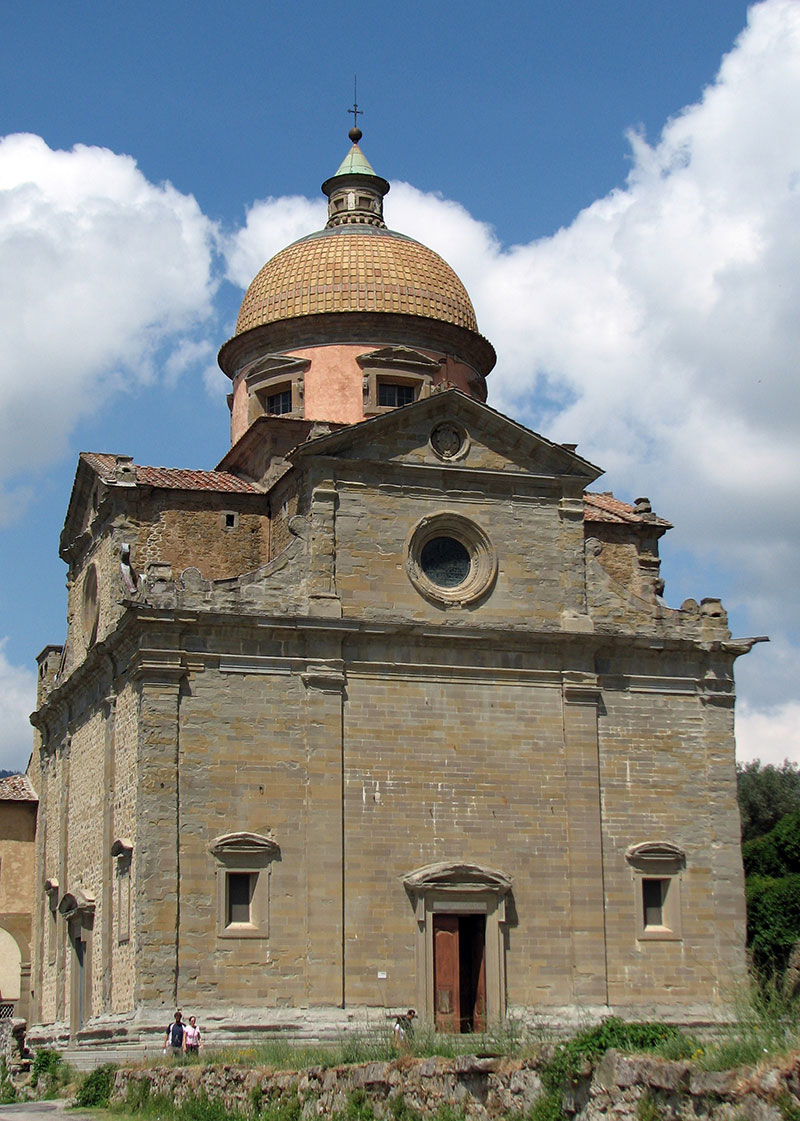
Santa Maria Nuova, built by Giorgio Vasari in 1554, is a domed church with a centralized Greek cross layout. Inside are four large columns which supports the lantern of the cupola. At the sides the four arms of the cross branch out covered with barrel-vaults, while four small cupolas arise in the spaces of the angles. The interior contains paintings depicting a Nativity by Alessandro Allori, San Carlo Borromeo administers communion to those afflicted by Plague by Baccio Ciarpi, and an Annunciation by Empoli. The church is in poor condition, and the interior is not open for visitors.
Santa Maria delle Grazie al Calcinaio was built in 1484–1515 by Francesco di Giorgio Martini to shelter a putatively miraculous icon of the Blessed Virgin Mary, the "Madonna del Calcinaio". This image was originally painted on the timbers of a lime-vat, a calcinaio, hence the name. A centralized Renaissance design was applied to the design of the nave: the eastern part of the building was generally developed into a centralized form, which would then be crowned with a large cupola, foreshadowing the cathedral at Florence. The restored interior has unusually high arches.
